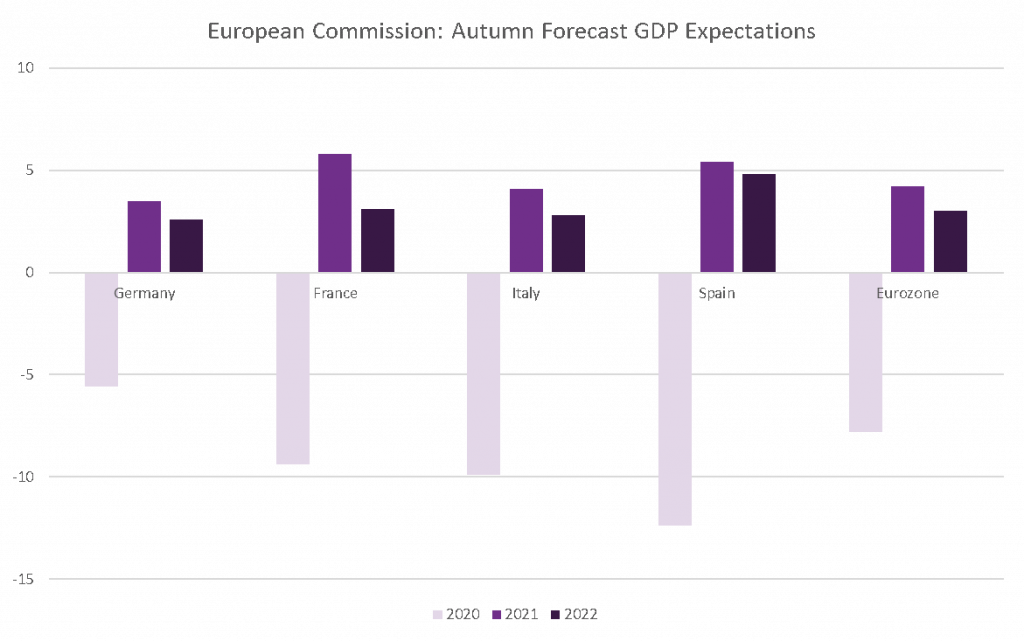The eurozone recorded its fastest rate
of expansion since records began in 1995 in the third quarter, but the European
Commission took the gilt off the gingerbread by revising down its growth
forecasts shortly after, pointing to the pandemic’s resurgence. Nonetheless,
more fiscal and monetary support is forthcoming.
Quarter-on-quarter, the eurozone economy
expanded 12.7% in Q3, versus 9.4% expected, but a new series of lockdowns,
curfews and restrictive measures threatens to put a spanner in the works. As
Maarten Verwey, European Director General Economic and Financial Affairs
comments, ‘The combination of renewed fear about the spread of the disease and
lockdown measures is weighing on economic activity in the short run and putting
the nascent recovery on hold.’ While, the EU commissioner, Paolo Gentiloni
said: ‘Growth will stall in the fourth quarter and pick up in the first part of
2021.’
A recovery on ice is much better than a
recovery falling into reverse. For now, a double-dip recession is not our base
case, however, it cannot be ruled out if new restrictions fail to contain the
virus swiftly.
After factoring new government-imposed restrictions into its forecasts, the European Commission’s Autumn Economic Forecasts predicted the EU economy to shrink 7.4% this year, unchanged from its previous forecast, but expectations for 2021 were cut by 2% from +6.1% to +4.1%. The broad figures, however, mask the very uneven recovery that is playing out, as seen below.

The economic trajectory of individual
countries has largely depended upon their ability to keep a lid on the pandemic
while, at the same time, countries with manufacturing at the heart of their
economy have managed to make a gradual comeback with supply chains mended and
export demand picking up. Those countries with service based economies,
especially those reliant on tourism, are still in the doldrums: The IHS Markit
Manufacturing PMI rose to 54.8 in October, while the Service equivalent came in
at 46.9. 50 is the level that separates contraction from expansion.
New mentions of the “R” word, the
unevenness of the recovery and the fact that inflation has been in negative
territory for three months in a row (most recently -0.3% in October), should
spur policymakers into further action.
On the fiscal front, now that the EU
Parliament has reached an agreement on the “rule of law conditionality”[1],
it is hoped that the EUR 750bn recovery package can start being disbursed
before the end of the year.
On
the monetary policy side, the ECB has primed us for even more stimulus at its
December meeting. The shape and size of the ECB’s Christmas present is subject
to speculation but consensus expects that the EUR 1.35 trillion pandemic
emergency purchase program will be expanded by six months until the end of
2021. Since the bond-buying plan was announced in March, the ECB has only used
half of the available money. Other predictions include an expansion of the
bank’s other asset purchase program which is running parallel to the PEPP,
buying EUR 20 billion worth of bonds per month, plus a “temporary envelope” of EUR 120 billion.
It’s currently scheduled to run until the end of this year. Cognizant of the
weight of negative interest rates on bank balance sheets, it may be expected
that the ECB expands its long-term lending scheme to banks rather than taking
the scissors to rates. The last thing the eurozone needs is for credit flows to
thin.
Then there is the chance that Ms. Lagarde chooses to add her own signature to the policy mix, bringing something entirely new to the table – after all, she did use the word “recalibration” some 20 times at her last press conference. The parcel will be unwrapped on December 10th and the contents had better not be a tangerine or a lump of coal, or else markets could get stroppy.
[1] A clause which states that EU countries
must uphold the European rule of law (i.e. judicial independence) or risk
losing access to the funds. The specification faced strong opposition from
countries such as Hungary and Poland.
Disclaimer
All financial data and/or economic information released by this Publication (the “Publication”); (the “Data” or the “Financial data
and/or economic information”), are provided for information purposes only,
without warranty of any kind, including without limitation the warranties of merchantability, fitness for a particular
purpose or warranties and non-infringement of any patent, intellectual property or proprietary rights of any party, and
are not intended for trading purposes. Banque Internationale à Luxembourg SA (the “Bank”) does not guarantee expressly or
impliedly, the sequence, accuracy, adequacy, legality, completeness, reliability, usefulness or timeless of any Data.
All Financial data and/or economic information provided may be delayed or may contain errors or be incomplete.
This disclaimer applies to both isolated and aggregate uses of the Data. All Data is provided on an “as is” basis. None of
the Financial data and/or economic information contained on this Publication constitutes a solicitation, offer, opinion, or
recommendation, a guarantee of results, nor a solicitation by the Bank of an offer to buy or sell any security, products and
services mentioned into it or to make investments. Moreover, none of the Financial data and/or economic information contained on
this Publication provides legal, tax accounting, financial or investment advice or services regarding the profitability or
suitability of any security or investment. This Publication has not been prepared with the aim to take an investor’s particular investment objectives,
financial position or needs into account. It is up to the investor himself to consider whether the Data contained herein this
Publication is appropriate to his needs, financial position and objectives or to seek professional independent advice before making
an investment decision based upon the Data. No investment decision whatsoever may result from solely reading this document. In order
to read and understand the Financial data and/or economic information included in this document, you will need to have knowledge and
experience of financial markets. If this is not the case, please contact your relationship manager. This Publication is prepared by
the Bank and is based on data available to the public and upon information from sources believed to be reliable and accurate, taken from
stock exchanges and third parties. The Bank, including its parent,- subsidiary or affiliate entities, agents, directors, officers,
employees, representatives or suppliers, shall not, directly or indirectly, be liable, in any way, for any: inaccuracies or errors
in or omissions from the Financial data and/or economic information, including but not limited to financial data regardless of the
cause of such or for any investment decision made, action taken, or action not taken of whatever nature in reliance upon any Data
provided herein, nor for any loss or damage, direct or indirect, special or consequential, arising from any use of this Publication
or of its content. This Publication is only valid at the moment of its editing, unless otherwise specified. All Financial data and/or
economic information contained herein can also quickly become out-of- date. All Data is subject to change without notice and may not be
incorporated in any new version of this Publication. The Bank has no obligation to update this Publication upon the availability of new data,
the occurrence of new events and/or other evolutions. Before making an investment decision, the investor must read carefully the terms and
conditions of the documentation relating to the specific products or services. Past performance is no guarantee of future performance.
Products or services described in this Publication may not be available in all countries and may be subject to restrictions in some persons
or in some countries. No part of this Publication may be reproduced, distributed, modified, linked to or used for any public or commercial
purpose without the prior written consent of the Bank. In any case, all Financial data and/or economic information provided on this Publication
are not intended for use by, or distribution to, any person or entity in any jurisdiction or country where such use or distribution would be
contrary to law and/or regulation. If you have obtained this Publication from a source other than the Bank website, be aware that electronic
documentation can be altered subsequent to original distribution.
As economic conditions are subject to change, the information and opinions presented in this outlook are current only as of the date
indicated in the matrix or the publication date. This publication is based on data available to the public and upon information that is
considered as reliable. Even if particular attention has been paid to its content, no guarantee, warranty or representation is given to the
accuracy or completeness thereof. Banque Internationale à Luxembourg cannot be held liable or responsible with respect to the information
expressed herein. This document has been prepared only for information purposes and does not constitute an offer or invitation to make investments.
It is up to investors themselves to consider whether the information contained herein is appropriate to their needs and objectives or to seek advice
before making an investment decision based upon this information. Banque Internationale à Luxembourg accepts no liability whatsoever for any investment
decisions of whatever nature by the user of this publication, which are in any way based on this publication, nor for any loss or damage arising
from any use of this publication or its content. This publication, prepared by Banque Internationale à Luxembourg (BIL), may not be copied or
duplicated in any form whatsoever or redistributed without the prior written consent of BIL 69, route d’Esch ı L-2953 Luxembourg ı
RCS Luxembourg B-6307 ı Tel. +352 4590 6699 ı www.bil.com.
Read more
More
December 1, 2025
Weekly Investment Insights
Thanksgiving meant that last week was cut short for the US stock market, but that did not stop major indices from ending the week higher....
November 24, 2025
Weekly InsightsWeekly Investment Insights
Even though last week brought some good news from both corporate earnings reports and economic data, global stocks ended in the red as fear over...
November 14, 2025
Weekly InsightsWeekly Investment Insights
The longest federal government shutdown in US history finally came to a close after President Trump signed the new funding package - which was narrowly...
November 10, 2025
Weekly InsightsWeekly Investment Insights
US tech stocks experienced their worst week since President Trump’s “Liberation Day” last week, with investors growing increasingly concerned about high valuations and elevated artificial...
